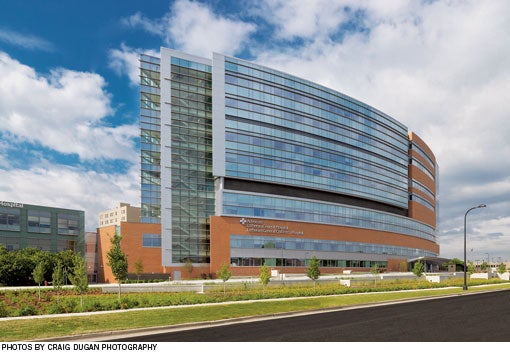LEED for Healthcare to help drive sustainable design

Advocate Lutheran General Hospital and Children's Hospital in Park Ridge, Ill., is certified as LEED Gold under USGBC's New Construction program. Architect: Cannon Design
Proponents of the U.S. Green Building Council's (USGBC's) new LEED for Healthcare are optimistic that the program will provide increased incentive for hospitals to design and operate facilities that are certifiably energy efficient and sustainable.
"I anticipate that LEED for Healthcare will be a catalyst for further market penetration in the health care sector, particularly as the human health and wellness, building performance and business-related benefits associated with green building are more broadly disseminated," says Gail Vittori, co-director, Center for Maximum Potential Building Systems, and founding chairwoman of the LEED for Healthcare Committee.
"The purpose of a market sector-specific LEED for Healthcare tool is to provide a customized product that addresses the unique challenges of health care construction. In turn, this should lead to broader market use," says Robin Guenther, FAIA, LEED AP, sustainable health design leader at design/architecture firm Perkins+Will.
"Clearly there are difficulties inherent in using a commercial office building rating system for hospitals that operate 24/7," she says. "Hopefully, the presence of a tool designed for health care will jump start registrations and certifications in this sector."
After six years of planning and negotiations, LEED for Healthcare was approved Nov. 16 by 87 percent of USGBC members who voted, says Melissa Gallagher-Rogers, director of market development, USGBC.
Project teams have the option of registering new licensed or federal inpatient or outpatient health care facilities for certification under LEED for Healthcare, but are not required to do so until the full certification process is launched in the spring, says Gallagher-Rogers. Prior to the new program, hospitals used LEED for New Construction to become certified.
While many of the credits for LEED for Healthcare are the same as LEED for New Construction, the new program takes into account some of the distinctive qualities of hospitals, especially the fact that they are open every day, around the clock, says Gallagher-Rogers.
Key LEED for Healthcare credits will be awarded for ventilation design linked to infection control, abundant daylighting, energy efficiency and building site, she says.
Gallagher-Rogers credited the Green Guide for Health Care for serving a crucial role in the development of LEED for Healthcare. "We were able to take the work done in the Green Guide — they had about 100 health care projects or so they were piloting in the Green Guide — and take the lessons and credits information developed there and use that in LEED for Healthcare. So we were able to bypass the need to have a pilot process for LEED for Healthcare."
Joseph Sprague, FAIA, FACHA, FHFI, senior vice president/director of health facilities, HKS Inc., Dallas, calls LEED for Healthcare a positive development. He says the program is catching up with what high-quality hospital design achieved 15 years ago.
"What it's done is it's taken good design and certified it," he says about LEED for Healthcare. "If you have been involved with good design for good design purpose, the sustainability element is a large part of that. Hospitals, in their new construction, for some time have been designing facilities that promote sustainable design principles."
Still, Sprague concurs with Vittori and Guenther that the new program likely will motivate new hospitals to strive for sustainable design, especially as aging health care building stock is replaced.
As of November there were 292 LEED-certified health care facilities in the country, says Gallagher-Rogers. About 1,400 health care facilities were registered for LEED certification.
For more information on LEED for Healthcare or to register a new hospital construction project for certification, go to www.usgbc.com.




